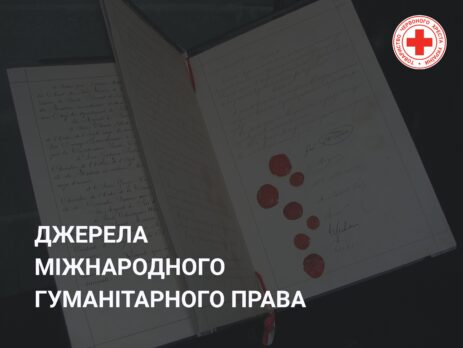The Main Sources of International Humanitarian Law: Customary IHL, Geneva Law, and Hague Law
International humanitarian law (IHL), which governs armed conflicts, is based on multilateral international treaties and customary international law. Like most countries worldwide, Ukraine is a party to these treaties and has committed to incorporating the norms of IHL into its national legislation. As part of its statutory mandate, the Ukrainian Red Cross systematically promotes awareness of IHL and supports the state in this area.
The most significant IHL treaties are the four Geneva Conventions of 12 August 1949, which aim to protect victims of war, together with their Additional Protocols. These include:
- The First Geneva Convention – for the Amelioration of the Condition of the Wounded and Sick in Armed Forces in the Field
- The Second Geneva Convention – for the Amelioration of the Condition of Wounded, Sick and Shipwrecked Members of Armed Forces at Sea
- The Third Geneva Convention – relative to the Treatment of Prisoners of War
- The Fourth Geneva Convention – relative to the Protection of Civilian Persons in Time of War
These international treaties collectively form the so-called Geneva Law, which is primarily concerned with the protection of victims of armed conflict. Historically, Geneva Law has been distinguished from Hague Law, which focuses on the regulation and limitation of the means and methods of warfare. Hague Law is based on other international treaties within the field of IHL, most notably:
- The Hague Convention (IV) Respecting the Laws and Customs of War on Land, 1907, including its annex, the Regulations Concerning the Laws and Customs of War on Land
- The Hague Convention for the Protection of Cultural Property in the Event of Armed Conflict, 1954, along with its First Protocol (1954) and Second Protocol (1999)
- The Biological Weapons Convention (BWC), 1972 (Convention on the Prohibition of the Development, Production and Stockpiling of Bacteriological (Biological) and Toxin Weapons and on Their Destruction)
- The Convention on the Prohibition of Military or Any Other Hostile Use of Environmental Modification Techniques (ENMOD), 1976
- The Convention on Prohibitions or Restrictions on the Use of Certain Conventional Weapons Which May Be Deemed to Be Excessively Injurious or to Have Indiscriminate Effects (CCW), 1980, including its protocols
- The Chemical Weapons Convention (CWC), 1993 (Convention on the Prohibition of the Development, Production, Stockpiling and Use of Chemical Weapons and on Their Destruction)
- The Ottawa Treaty (Mine Ban Treaty), 1997 (Convention on the Prohibition of the Use, Stockpiling, Production and Transfer of Anti-Personnel Mines and on Their Destruction)
In contrast to treaty-based IHL, whose rules are documented and set out in international treaties, customary IHL consists of universal principles developed over time and derived from general practice accepted as law. It operates alongside treaty-based IHL, filling gaps and strengthening the protection of victims of armed conflict.
Follow the official publications of the Ukrainian Red Cross to stay informed and raise awareness about international humanitarian law.

